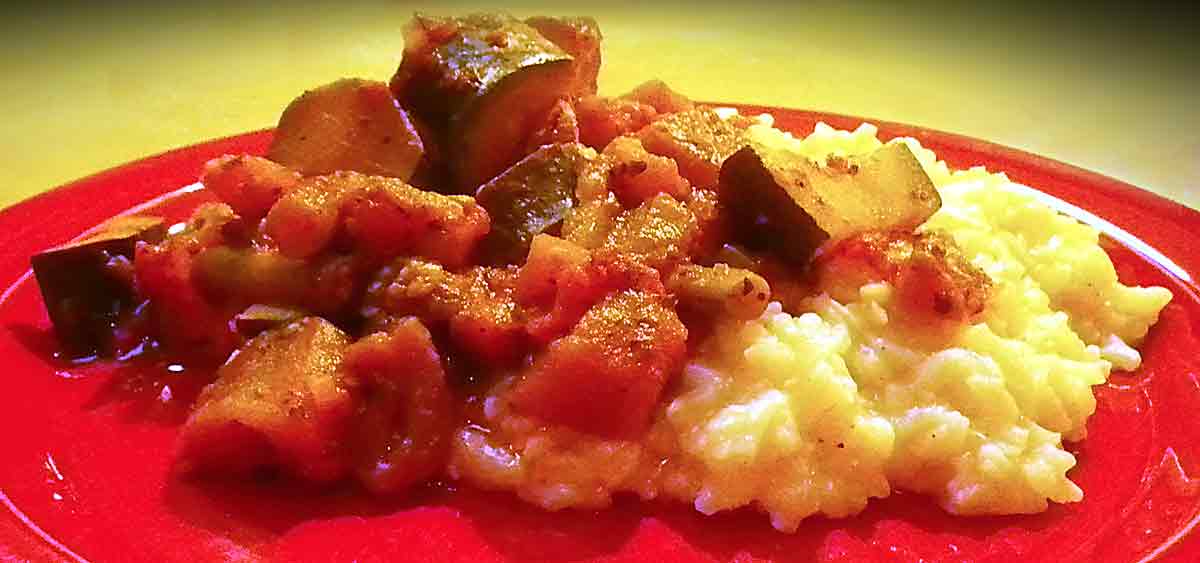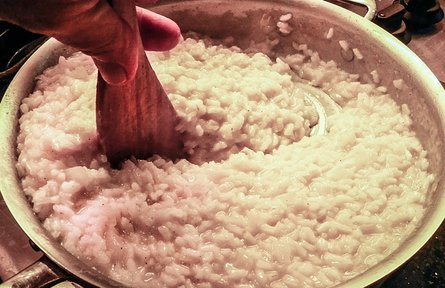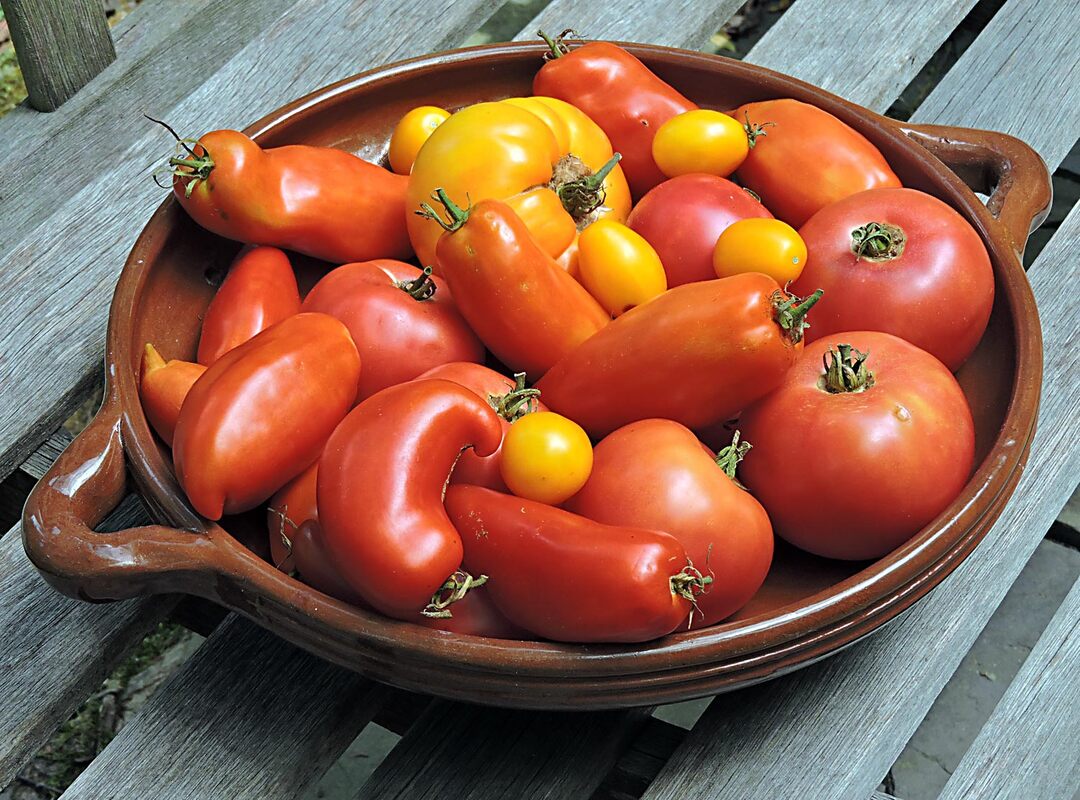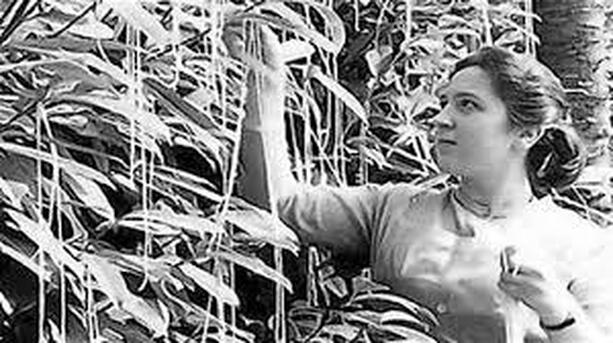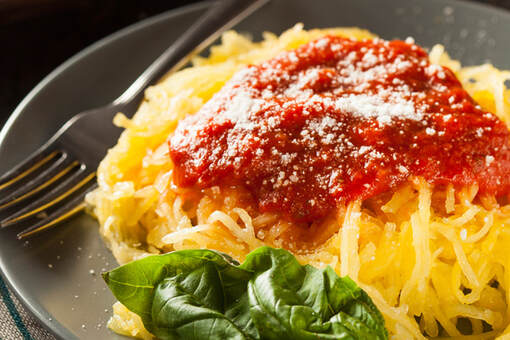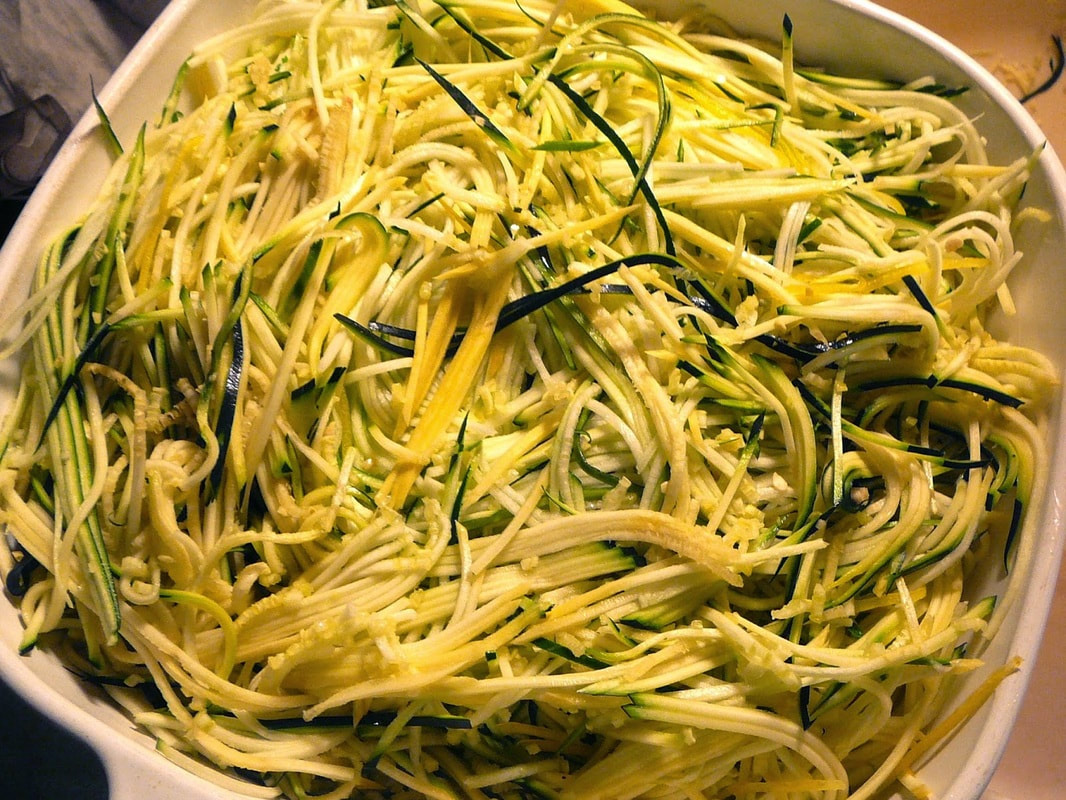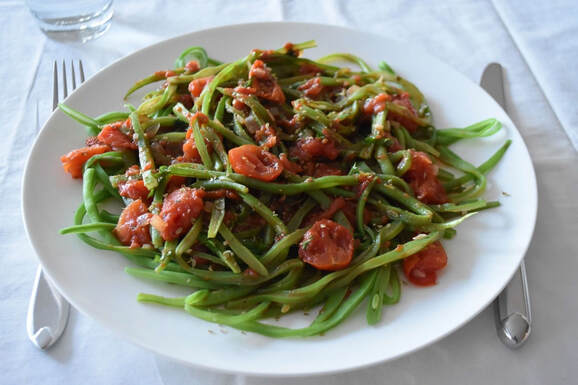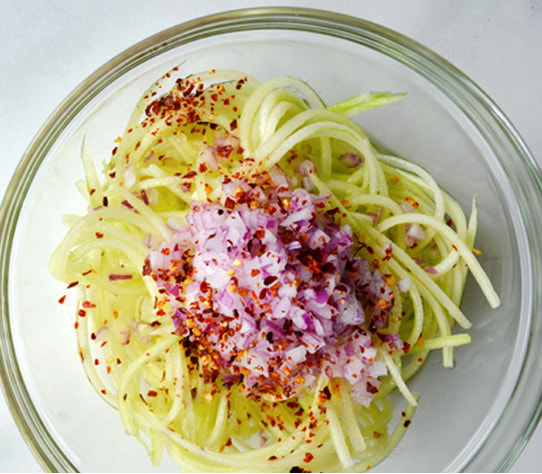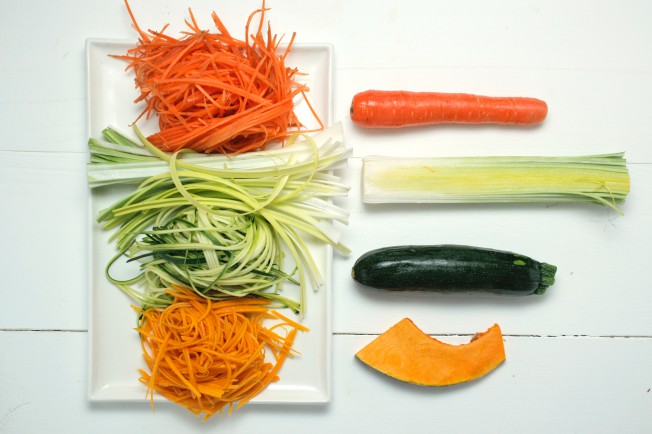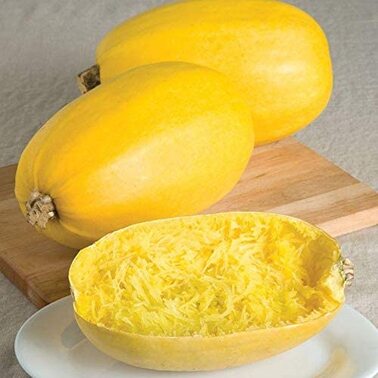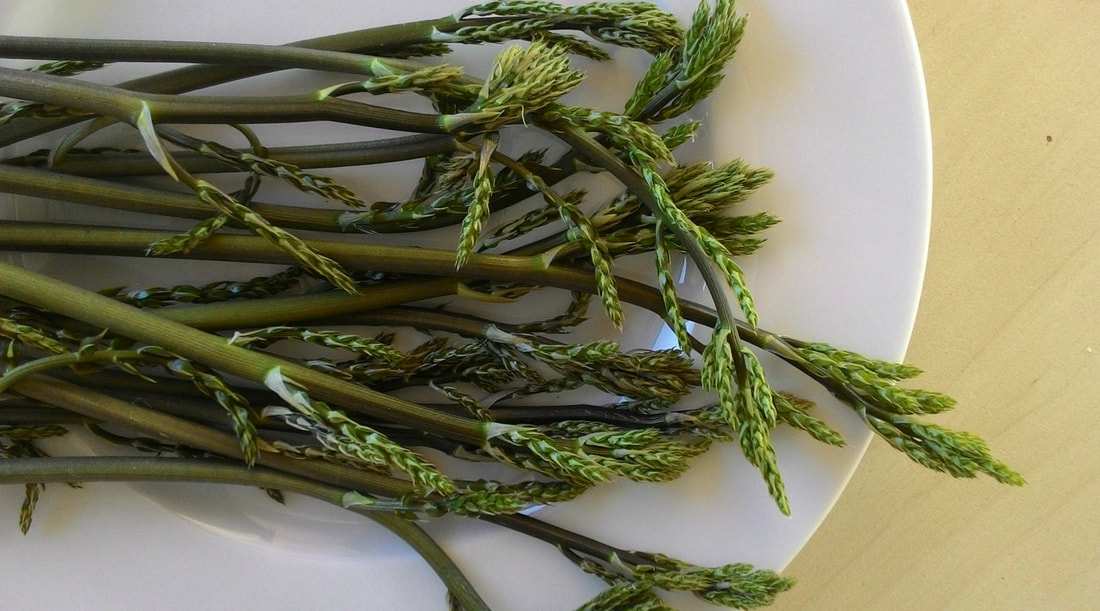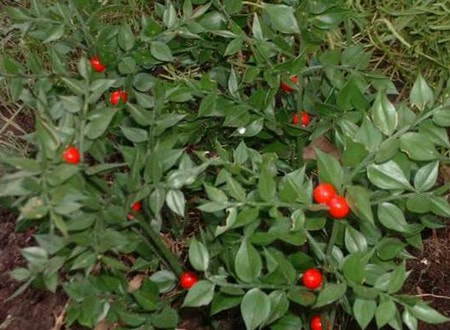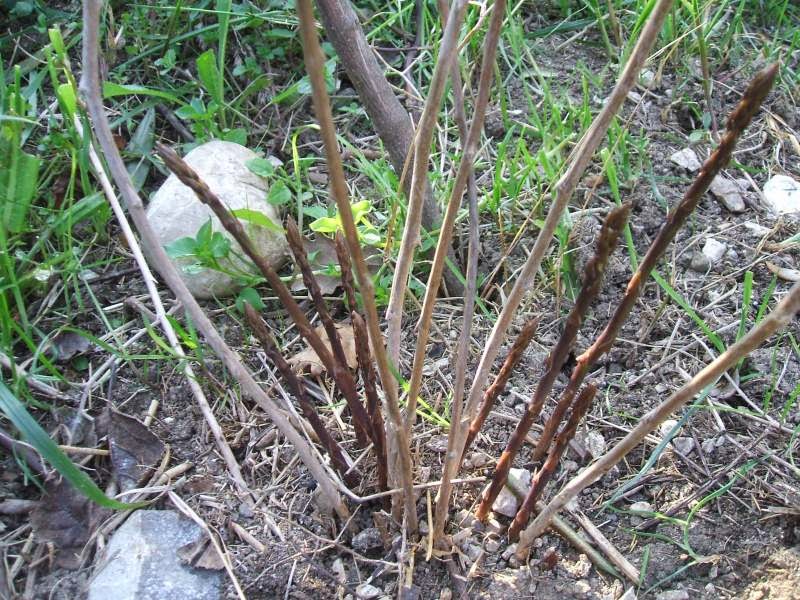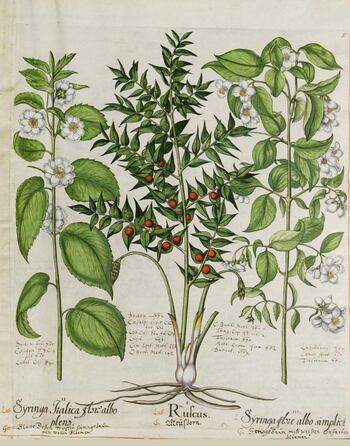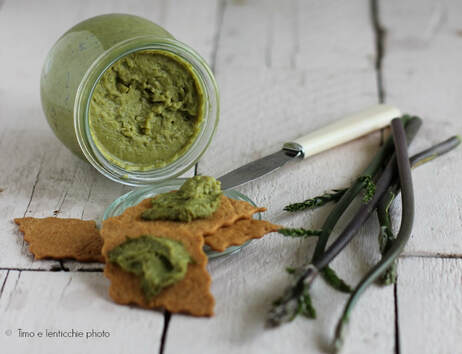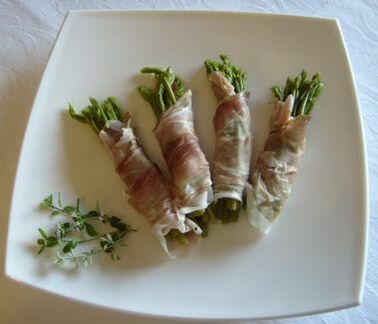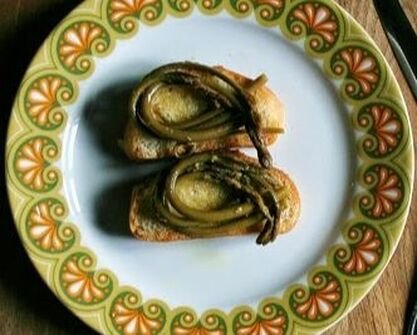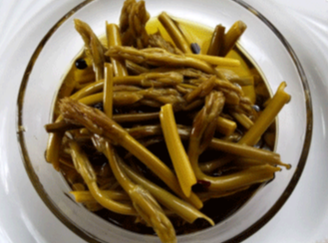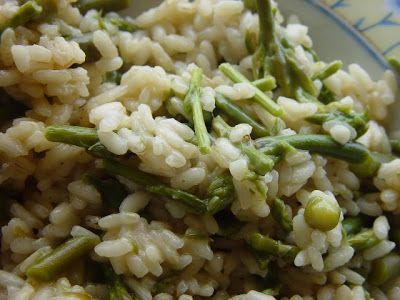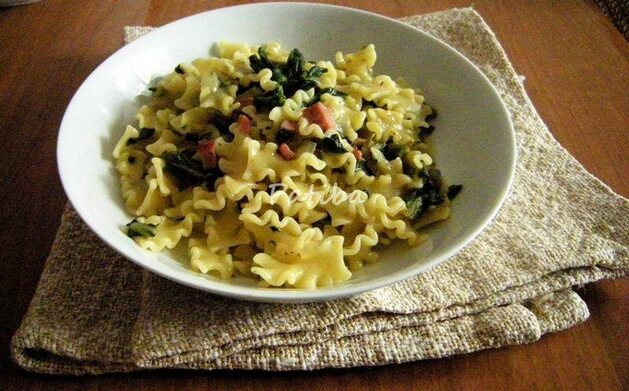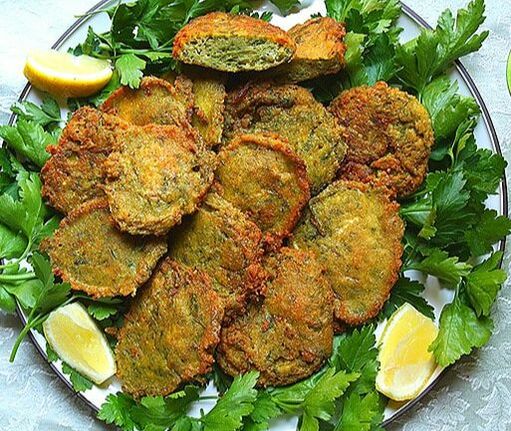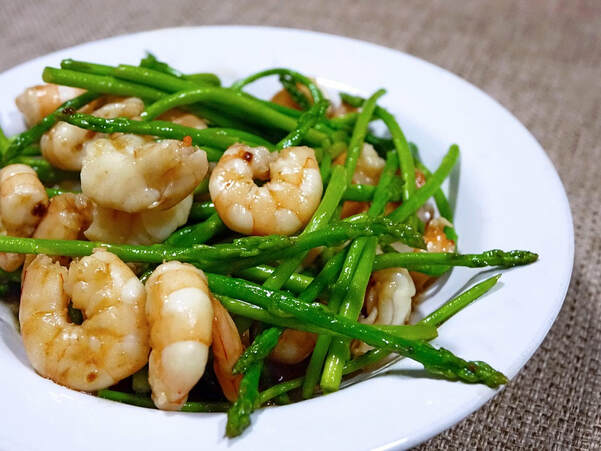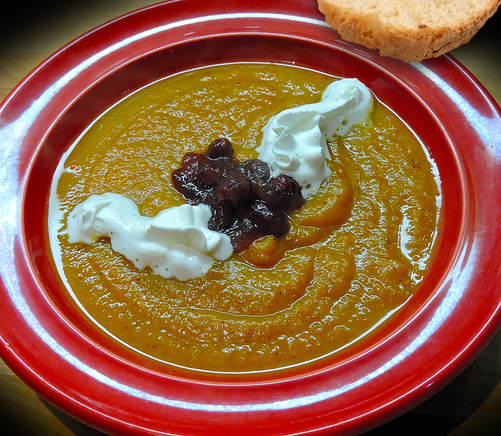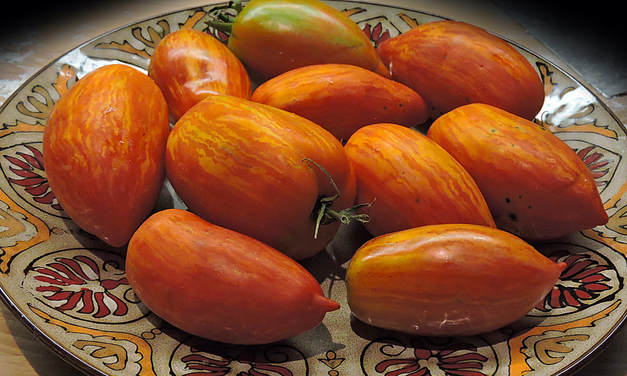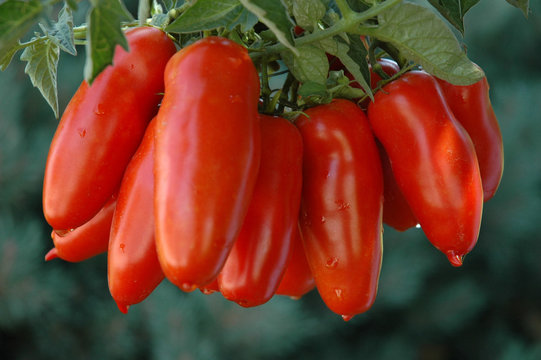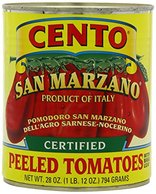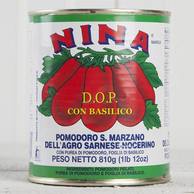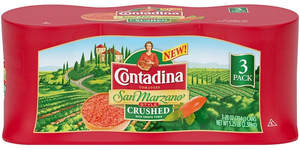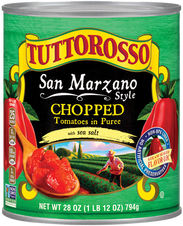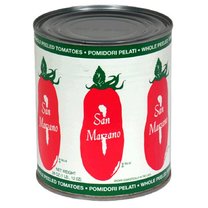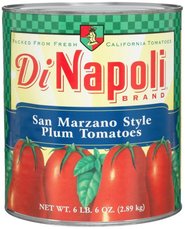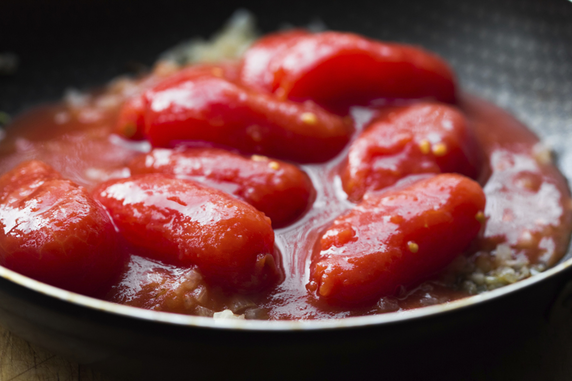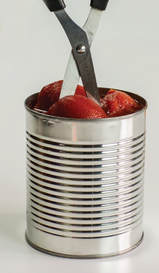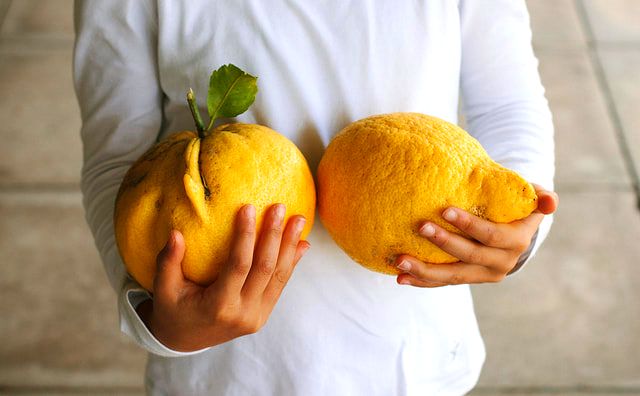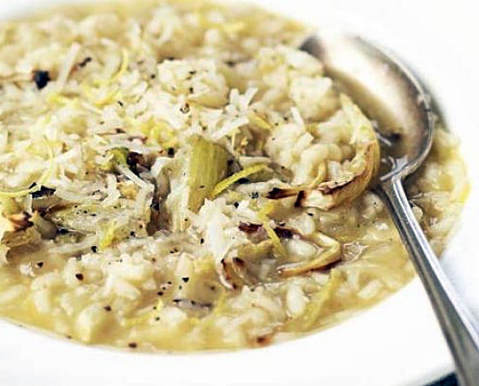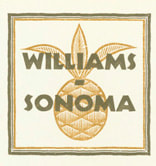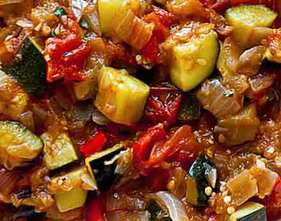 My son, Lucas loves the animated film Ratatouille, and so do Lisa and I. It's a wonderful jaunt through a vintage Parisian kitchen through the eyes of "Little Chef", a rodent who loves to cook. After seeing the film, Lucas wanted to make ratatouille, so we set out to do a rustic, delicious version and have made it many times since. But ever since re-discovering our Italian roots during our Grand Voyage of Italy, we have been concentrating more on Italian recipes. Well, this time we though we'd combine the best of both worlds--French country cuisine with the height of Italian culinary skills--in the making of a great risotto. I think we succeeded with our Ratatouille & Risotto. It's perfect for autumn or winter--a stick to your ribs supper. But this dish has two distinct personalities... the obvious simplicity of making the ratatouille--basically a vegetarian peasant stew--and the technically demanding risotto. For the Ratatouille Ratatouille is a very basic vegetable stew made in Provence and around Nice in southern France. It uses several basic ingredients: eggplant, zucchini, tomatoes, onion and pepper. There are many variations on the recipe, but the one I use is fairly rustic and traditional. Ingredients: 1 large Vidalia (sweet) onion - diced 1 bell pepper, diced 2 medium sized eggplant-skinned, cut into 3/4 -1" cubes, (the larger the eggplant, the more seeds and more bitterness) 5-6 whole garlic cloves 3-4 young, slim zucchini - skin on, sliced once lengthwise, then into 3/4" half moon slices, (smaller & younger are more sweet and less seedy) 1-16 ounce can of diced tomatoes (I use Del Monte, oregano & basil spiced, in summer use fresh heirloom paste tomatoes) 1 cup chicken (or vegetable) broth 1/4 cup port wine 1 tablespoon salt 2 tablespoons oregano 1 tablespoon rubbed sage 3 bay leaves (remove after cooking!) 40 cracks of fresh pepper (from a pepper mill, fine grind) 1/2 teaspoon hot pepper flakes Olive oil for sauteing
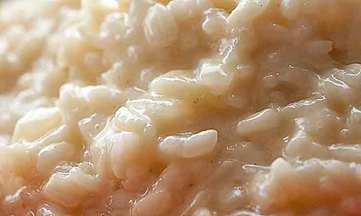 For the Risotto We mainly use Arborio rice when we make risotto, but even better is if you can find Canaroli rice--it makes an even creamier risotto and is a bit more forgiving. The trick with making risotto is patience. It can take the better part of an hour or more--constantly adding broth and stirring--until the starchy exterior of the rice breaks down enough to make a creamy risotto, while still keeping a pasta-like "tooth" in the cooked rice. You don't want any crunch, there shouldn't be any mushy rice, and the texture when finished should be loose, glistening and creamy. While there are some tricks for making risotto faster, but there's no substitute for a strong arm and standing at the stove top for up to an hour... Ingredients: 2 cups arborio or carnaroli rice 2 tablespoons light olive oil 1 medium sweet onion (or half a large Vidalia)-diced finely 1 cup dry white wine (Frascati or Pinot Grigio, or one of your choice) 6 cups of chick or vegetable broth, heated in a saucepan (for ladling into the rice) 1/4 teaspoon salt 1/2 stick unsalted butter 1-1/4 cups of finely grated Parmigiano-Reggiano cheese (plus additional for topping off the dish)
Toward the end, you will notice the starch in the rice being released to make a creamy consistency. Occasionally, taste the rice to make sure it is cooked through while still having a little bit of "tooth". You do not want it mushy, but you don't want crunch on individual grains. You will also know when the rice is nearing completion when you experience a sort of "wave" when you stir the rice, making a circular motion with the flat edge of your spoon around the bottom of the pan. Italian chef's call this the all'onda (wavy) effect. When your spoons passes and the rice behind it slides back in a slow motion like a silky wave, the risotto is at the right texture.
Some recipes say that this will take only 30-35 minutes, but I have found it takes me 45-65 minutes until the rice is cooked and getting creamy. Risotto should be served immediately when completed, so timing is key. But in the event you have to let your risotto sit for a bit, just leave covered, unheated... then before serving, revitalize it by heating it with a little bit more hot water on a medium low flame until the water is incorporated and it has reached the "wave" stage once again. To service, place a portion of the risotto on your plates and add some ratatouille on top, toward one side (let the creamy risotto show itself off too). You decide to have a hearty Italian Chianti or a nice French Bordeaux with the dish... after all, it does have a split-personality. I'd also like to add that the risotto recipes used in this dish is a basic risotto recipe. Once you learn how to make this, you can experience with adding all sorts of other things into the risotto... mushrooms, saffron, peas, shrimp, etc. And the ratatouille recipe is great topping a pizza, with pasta or even as a filling for a stuffed baked potato! Buon appetito! --Jerry Finzi Copyright 2016, Jerry Finzi/Grand Voyage Italy - All Rights Reserved
These are about 6 pounds worth of just a few of the 11 varieties of heirloom tomatoes we are growing in nostro giardano this year... The Large yellow beefsteak is Regina, the horn-shaped one is Jersey Devil, the small yellow grape shape is Olivette Juane, the large pink globe tomato is Giant Belgium (not so giant this season), and the smaller pink ball shape is Eva Purple Ball. All long lasting friends that I have grown for a couple of decades. All absolutely delizioso. Happy pesto season, tutti! --Jerry Finzi You might also be interested in...
I'm not a gullible man. Even as a boy, I wasn't one to believe everything I was told. I always asked questions... "Why? Where? When? How?" I read lots of books, including my entire encyclopedia set and my Atlas. I loved science and the arts. I used both sides of my brain. But as a 12-year-old watching the old Jack Parr show in 1963, I tended to to go by the old adage, "Seeing is believing"--especially if you see it on TV! Big mistake! What I saw was a very legitimate sounding short documentary film with a very scholarly, British voice talking about the spaghetti harvest in Switzerland, and mentioning the "tremendous scale of the Italian's... (harvest)" and the "vast spaghetti plantations in the Po valley". From that point on, until I was in my early twenties, I actually believed there was some sort of special tree or bush in Italy that produced some sort of spaghetti... fruit, pod or otherwise. It wasn't until I saw Jack Parr himself talking about the hoax on the Tonight Show in the early 1970s that I learned the embarrassing truth--a "truth" that I would argue about with my non-Italian friends growing up... "Real Italian spaghetti grows on trees!", I would insist. Parr claimed they didn't get a single call about the segment and most people bought it hook, line and sinker. OK, so maybe I was a bit gullible. But it was a very convincing documentary film, produced originally as a serious film for, of all things, a British news show... and besides, I was only 12! On April 1, 1957, on April Fool's Day (Pesce d'Aprile in Italian), the BBC television show Panorama aired the short "documentary" about the "spaghetti harvest" in Ticino, Switzerland, on the border of the Italian Alps. The film shows spaghetti trees ripe with long strands of spaghetti and a farming family harvesting by hand, putting the spaghetti into baskets and then carefully laying them out to dry in the "warm Alpine sun." Some viewers bought it entirely and called BBC to find out where they could buy some of the "real spaghetti". Many British gardeners wanted to know how to buy a spaghetti bush for their own garden. Others were very angry that a joke was portrayed as a serious subject on a real news program. Still others--like me--just tucked this into their knowledge banks, unquestioningly and carried it as a "truth" through at least part of their lives, being even more convinced every time they heard the expression "fresh pasta"... of course, that must be referring to the real stuff fresh picked from the trees! What did I know. After all, neither my Mother or Grandmother made fresh spaghetti, because spaghetti trees probably didn't grow in our climate. All I ever saw growing up was dried, boxed spaghetti--you know, the fake stuff. The following video is the original broadcast in 1957 in England... The following video gives a behind the scenes take on the Spaghetti Hoax story from a member of the Panorama production team who came up with the idea... The next video shows a further chapter of this hoax broadcast in 1967 in Britain explaining how the spaghetti crop was being ruined by a terrible pest--the spag-worm, or "troglodyte pasta". ("Troglodyte" refers to a person so stupid because he lives in a cave). In 1978, San Giorgio Pasta produced a remake of the Spaghetti Hoax for one of their TV ads. Finally, cooking know-it-all, Martha Stewart (I'm not a fan) got into the act in 2009 with her own little spoof about her Spaghetti Bush, "spago officinalis" ("official string") trees.  Italian snake bean seeds on Amazon Italian snake bean seeds on Amazon Well, I've had a lot more culinary education since being misled by that little April Fool's prank when I was young and impressionable: my Mom and Dad taught with every loving dish they put in front of me; Grandma taught me her authenticity; having home and studio in Manhattan for so many years where varied cuisines are around every corner also taught me; In my 30s, I finally learned how to cook from Julia Child, Craig Clairborne, Marcella Hazan, Mary Ann Esposito and Pierre Franey. I now make fresh pasta with my son, Lucas from time to time. And during our Voyage throughout Italy, I never saw a single strand of spaghetti on a bush, tree or vine. Ever. (OK, so I did look, just to be sure.) However, I have since learned that there are actually spaghetti alternatives that grow from Madre Terra. I even grew 2 foot long "snake" beans a few years ago that came pretty close. Here are a few veggie spaghetti alternatives... If you want to make your own, fresh "veggie spaghetti" at home, pick up a Premium Vegetable Spiralizer from Amazon or the attachment we use for our stand mixer, the Kitchenaid Spiralizer Attachment. It's a lot easier than picking the spaghetti from the trees, collecting in baskets and spreading them out in the sun to dry...
(Damn you, Jack Parr and your dry sense of humor!) --Jerry Finzi Pungitopo (also known as Butcher's Broom) might be a popular plant for use in natural healing remedies, but it is often found while hiking in the mountains of Italy for use in local, traditional Italian recipes. Pungitopo tends to grow wild as an evergreen bush (looking like a short, bushy holly) with asparagus-like sprouts in fall. It is gathered in bunches about 12" tall and used in la cucina in the same was as asparagus. Tied with string and steamed until tender, it's often eaten as a side dish or wrapped in prosciutto, The sprouts, called ruscli (rusculins in English) are the tenderest part. Pungitopo is actually a member of the lily family closely related to asparagus botanically speaking. It and was once used in Europe make small brooms to clean butchers' chopping blocks. It's scent had the ability deter rodents from taking an interest in meats hanging to cure. The plant is well known throughout Italy, Europe and to the British Isles. Other common names are jew’s myrtle, sweet broom, kneeholy, pettigree, knee holly, kneeholm. In Italy, they will also be known as asparagi selvatici (wild asparagus) or portafortuna natalizio (Christmas Luck), referring to the time of year it is usually enjoyed in the Italian kitchen. It is mostly harvested nowadays for its thick, brown rhizome, which is harvested in the fall when the plant stores most of its energy for winter. It's herbal use is to make healing teas. There use can be as simple as boiling or steaming and served with butter or olive oil, the was asparagus are served. The softer buds are used in fritatta, frittella (fritters), risotto or in pasta dishes. Their taste is bitter but the buds alone are a bit sweeter. Here are a few ideas...
--GVI Acquasala (or Acquasale, Acqua Sala) is one of the cucina povera--poor dishes--of southern Italy, especially in the Lucane Dolomites of Basilicata and olive oil rich Puglia. this simple fare was enjoyed by farmers and shepherds. Its close cousin is panzanella, a sort of salad that uses torn up pieces of stale bread reconstituted with water as its base. Acquasala is a dish made from the simplest ingredients that any peasant contadina had around: eggs, onion, water, peppers or tomatoes and especially, the stale bread. Think of it as a mashup between eggs Benedict and an Italian broth, where the broth replaces the Hollandaise sauce. Perfect for breakfast, brunch or even a light dinner.  Friselli Friselli In it's simplest form, an acquasala is stale, crusty bread topped with a poached egg and a flavored broth poured over. The bread soaks up the resulting broth and its flavors. I'm certain that others in southern Italy might replace the stale bread with Friselli, a bagel-shaped, bone-dry toasted bread sold in bags in southern Italy. One easy to find bread nowadays is the ciabatta, left to go a bt stale or with the thick slices toasted before use. Don't think of this recipe as being ironclad in terms of the ingredients. Be creative. This is cucina povera, after all, which means that cooks used what they had on hand depending on the season: eggs from their chickens, stale bread, tomatoes, peppers, asparagus, eggplant, zucchini, white or red onions, a bit of garlic, mushrooms and greens. Southerners loved their greens, whether a bit of dandilion, arugla or chives. To be absolutely authentic, warm water (not boiled) is traditionally used to make the "broth", with the peppers and onions added to it for a light fusion of flavors. In Puglia it's often made without eggs and many more more ingredients, a cross between a soup and a salad. 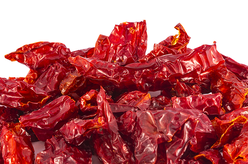 Pepperone Crusco Pepperone Crusco Acquasala Lucan Ingredients (serves 2, with one egg each)
Directions
Boun appetito! --Jerry Finzi Pugliese Acquasala... Copyright 2019, Jerry Finzi/GrandVoyageitaly.com - All Rights Reserved
Not to be published without expressed authorization 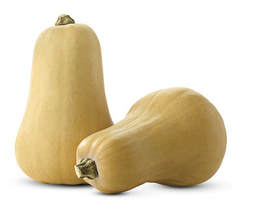 One of our favorite soups during the Christmas season or anytime during winter is Roasted Butternut Squash Soup. Although you can make this simply by cutting up the squash into cubes and adding them directly to your other ingredients, additional depth of flavor is gained by roasting halved Butternut squash in the oven before adding to the soup. This can also be made using smaller Acorn squash which has a similar taste and texture. Ingredients 2 butternut squash (or one very large one), halved with seeds scooped out and discarded. 3-4 large carrots, diced (they add texture and sweetness). 1 large sweet onion, diced (Vidalia is best) 1 tablespoon sugar 3 tbsp. extra-virgin olive oil 1 tablespoon sea salt 40 cracks of freshly ground pepper (or 1 teaspoon) 1 tablespoon dried thyme 1/4 teaspoon nutmeg 1/4 teaspoon allspice 32 ounces chicken broth Plus, additional water or cream as needed to adjust creaminess For the Garnish 2 cups fresh cranberries (You can also use canned, whole cranberries as your garnish) 1/4 cup sugar 1/4 teaspoon allspice 1 teaspoon lemon juice 1 pint of heavy cream (for whipping) 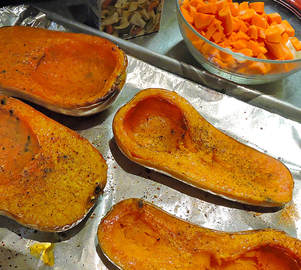 Directions
Serve with some crusty, heated bread and a glass of Prosecco. Buon appetito! --Jerry Finzi Copyright Grand Voyage Italy, 2018 - All Rights Reserved
My all-time favorite tomato is Eva Purple Ball--a pink-purplish, 2-3" round globe heirloom tomato that I've been growing for almost 20 years. ("Sweet like sugar", as my Dad always said about his home grown tomatoes). Eva is impeccably disease resistant, with a smooth, flawless skin and produces well. Next in line is Giant Belgium--a large, pink beefsteak tomato. Like Eva, it has a rich, sweet flavor, but large enough for one slice to cover a small dessert plate (great for caprese). But last year I found a fat, orange striped tomato in a local farmers' market that I fell in love with. I saved seeds from one of the biggest ones and planted two plants this season. Well, I'm in love again! This tomato is a large, plum style that grows about 3-5-1/5" long, with a pointy end (often with a very pointy nipple). Some grew so fat that I could not wrap my hand around them. It's very fleshy with low acidity--perfect for making sauce. But it's very sweet! I've gotten into slicing ovals on the bias for my panini and American style hoagie sandwiches. I've made sauces twice for pasta, and even used them sliced as a pizza topping (like I'm doing again tonight).
The only problem is, the chipmunks in my garden love them almost as much as I do.But even with those few losses, I'd estimate that the two plants produced about 20 pounds of these so far, and there's still a few on the plants coming ripe. I did several Google image searches until I verified the type--Striped Roma. I've already saved seeds for next season... You can find some seeds HERE. God, I love tomatoes. Home-grown, that is. --Jerry Finzi San Marzano tomatoes are the holy grail when it comes to sauce tomatoes. They often cost twice the price of other canned tomatoes, which is the reason why there are many counterfeit, bogus tomatoes in cans labeled San Marzano, or "San Marzano style". Experts say that up to 95% of the tomatoes labeled "San Marzano" are tomatoes grown in other regions of Italy or other countries. The Italian Mafia and other unscrupulous organizations will place lesser quality tomatoes into cans and label them as San Marzano, when in reality they are a mixture of less sweet, less meaty tomatoes. In was in 2011 that the president of Consorzio San Marzano (Consortium for the Protection of the San Marzano Tomato Dell'agro Sarnese Nocerino) said that only five percent of tomatoes marked as such are certified, D.O.P. San Marzano tomatoes. San Marzano tomatoes are elongated plum tomatoes that by decree, must be grown in Agro Sarnese-Nocerino, an area surrounding Mount Vesuvious near Naples. When they are canned, they come with a D.O.P.-Denominazione d' Origine Protetta (literally “Protected Designation of Origin”) emblem on the label, marking their authenticity. This is the same type of certification that ensures the authenticity of other Italian products, such as Parmigiano Reggiano, Prosciutto di Parma or Balsamic di Molena. To ensure you are getting San Marzano tomatoes, make sure that the can has one of the following on it: "Certified San Marzano", the DOP emblem, or the words "San Marzano dell'Agro Sarnese-Nocerino". The ingredients should list "whole (or peeled) San Marzano tomatoes". Some producers also include a statement something like, "San Marzano tomatoes (DOP-protected designation of Origin) are only cultivated in 41 approved municipalities, from San Marzano seeds, within the Sarno River valley surrounding Naples (or 'near the slopes of Mount Vesuvious'), in the Campania region." If the label says, "Grown in the USA", steer clear. Certified Authentic San Marzano Tomatoes The Phony Stuff 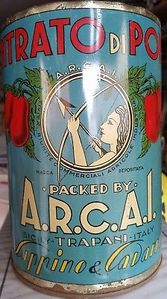 A 1940s era canned tomato that might be San Marzano A 1940s era canned tomato that might be San Marzano Compared to the Roma tomato, San Marzano tomatoes are thinner, a bit longer and pointed at their ends. The thicker, meatier flesh has fewer seeds and is fantastic for making sauce. The taste is also stronger, sweeter and less acidic. (I've had pizza from one local chic, wood oven pizzeria who claimed the tomatoes in their sauce were San Marzano, but the amazingly high acidic level burned my lips. I called BS.) As many know, the tomato itself was imported to Europe after being discovered in the New World. Its first culinary appearance was in a 1692 cookbook as a base for a sauce. The San Marzano itself doesn't show up until much later, in a tomato manual published in 1940, the San Marzano is listed as a "recent cross" between the Re Umberto and Fiaschetto varieties. 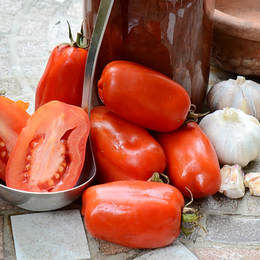 The San Marzano vines are indeterminate type, and have a somewhat longer season than other paste tomato varieties, making them well suitable for warmer climates. Indeterminate tomato plants will keep producing fruit as long as the warm, sunny weather lasts, whereas determinate varieties produce only a set number of fruit on shorter plants, and then die. Many heirloom tomatoes are indeterminate type (like the varieties I grow, producing 8' plants). San Marzano is an "open-pollinated", heirloom variety that breeds true from generation to generation, making seed saving practical for the home gardener or farmer. You can't save seeds from hybrid tomatoes because they cross-pollinate, which results in pot-luck tomatoes appearing on the vine. If you can get some authentic, D.O.P. San Marzano tomatoes while in Campania, save some seeds to plant in your home garden, although they won't have the D.O.P. designation, they will be fairly close the what is grown in Campania. (Of course, you can't exactly match the weather or soil qualities). You can also grow San Marzano seeds purchased from heirloom seed companies, but these wouldn't be from tomatoes harvested in the Sarno Valley area. You will find that even the highly respected Seedsavers Exchange doesn't list any "San Marzano" seeds out of respect for the D.O.P. designation of the originals. So, the next time you're in the Naples neighborhood, buy some San Marzano fruits and save the seeds. There's nothing like home-grown tomatoes, as my father always said... --Jerry Finzi
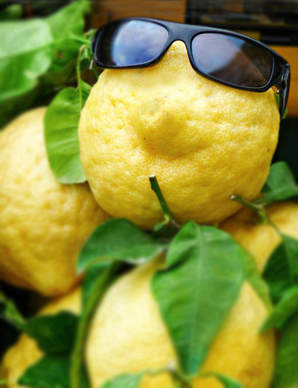 by Jerry Finzi While exploring the villages of the Amalfi Coast, Voyagers are certain to notice that the lemons there are larger than they are used to. They are sure to come across the Sfusato lemon (about two to three times the size of a supermarket lemon) and will be further shocked when they are confronted with the giant-sized, Cedro Citron variety of lemons. They are beastly looking things, with a pebbly surface, strange shapes with a large nipple at one end, and are often as big as your head! 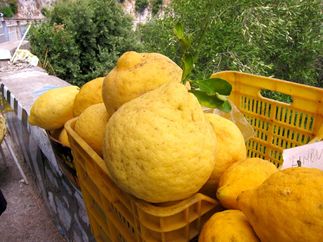 Cedri are primarily found in Italy, from the Italian Riviera down to the Amalfi Coast, though they are occasionally spotted in France, Isreal and even exported to Britain. There are three different citron types: acidic, non-acidic and pulpless. Of the different cultivars, the acidic Diamante is more common in Italy. Cedro citrons are usually up to three to four times the length of common lemons and can measure between 10 and 15 inches in diameter. They can weight up to 3-4 pounds each. The pebbly surface ripens from green to a bright yellow--both colors can be harvested, the peak season being fall and winter. Most--about 70%--of the lemon is white pith from 2-5 inches thick with a soft texture and almost sweet lemony fragrance. In its center is a small amount of segmented pulp with a few pale seeds. This lemon is fairly dry and not used for its juice and the taste is milder than a common lemon. 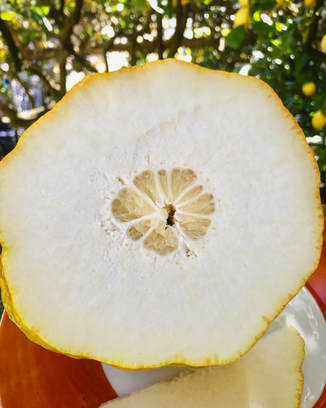 The pith can be eaten raw or cooked: in salads, atop bruschetta, in jams and preserves, in risotto or pickled. The rind of this citron is very aromatic and a bit sweet, and is used to produce "citron", or candied lemon (used in Italian celebration breads and cakes, like panettone). Some claim it can be a remedy for hangovers, coughs and indigestion. Since the Renaissance, the oils from the skin have also been used in perfumery and cosmetics due to their delicate and fragrant scent. If cooking while in Italy (or if you can get some cedri at home), try these recipes: Risotto alla Sorrento with Fennel and Sage 1 Cedro lemon 1-1/2 cups rice for risotto (Carnaroli, Vialone Nano or Arborio) 1-1/4 cups freshly grated parmesan 1 tablespoon unsalted butter, plus another tablespoon to finish 4 tablespoons Extra virgin olive oil 1 head of finoccio (bulbing fennel) - finely diced 3 stalks celery - finely diced 1 cup white white Vermouth 1 quart chicken stock 4 large julienned sage leaves (or 1/2 teaspoon dried-crushed) Sea salt and freshly ground black pepper to taste Directions
Candied Chocolate Cedro Strips Recipe (A great holiday snack) 1 - 2 pound cedro 1 cup sugar 1 pint water 3-5 ounces bitter sweet chocolate
You can store these in an airtight container and serve at the end of a meal with fruit, nuts, biscotti and espresso. © GVI 2018 You might also be interest in:
When Life Gives Them Lemons, Italians Make Limoncello Amalfi Lemon and Chicken Pasta Lemon and Turkey Pasta with Prosecco |
Archives
May 2024
Categories
All
|

